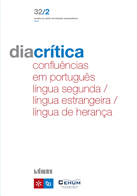On the use of the capital letter by Portuguese heritage language students in Switzerland. A case study
DOI:
https://doi.org/10.21814/diacritica.5031Keywords:
Portuguese Heritage Language, Orthographic norm, Transfer, Spelling deviations in the use of capital lettersAbstract
This article focuses on a case study developed in 2017 with a sample of Portuguese Heritage Language students, living in Zürich (Switzerland), and intends to be a reflection on the deviations in the graphic representation of the capital letter by some bilingual Portuguese descent students. Starting from the empirical hypothesis that the cause of these deviations consists in the transfer from German to Portuguese, the intervention procedure implemented in the group of informants under study was based on a sequence of two exercises atdifferent evaluative moments, allowing, in this way, to collect and analyze data, inorder to assess the class and subclass of words that register the highest percentage of deviant occurrences and to understand if the metalinguistic reflection contributes (or not) to the use of capital letters in accordance with the European Portuguese orthographic standard.
References
Arruda, L. (2014). Gramática de Português Língua Não Materna. Porto, Portugal: Porto Editora.
Azeredo, M., Pinto, M. & Lopes, M. (2007). Gramática Prática de Português – Da Comunicação à Expressão. Lisboa, Portugal: Lisboa Editora.
Barbosa, M. P. & Flores, C. (2011). Clíticos no português de herança de emigrantes bilingues de segunda geração. In
Textos Selecionados, XXVI Encontro da Associação Portuguesa de Linguística. Lisboa, Portugal: APL.
Carreira, M. (2013). When heritage and non-heritage learners come together: Differentiation for mixed classes.
Davis Language Center.
Eisenberg, P. (2013). Das Wort – Grundriss der Deutschen Grammatik: Band 1. (4.ª ed.) Stuttgart, Alemanha: J. B. Metzler. DOI: https://doi.org/10.1007/978-3-476-00743-8_1
Estrela, E., Soares, M. & Leitão, M. (2004). Saber escrever, saber falar – Um guia completo para usar corretamente a língua portuguesa. (4ª ed.) Lisboa, Portugal: Dom Quixote.
Flores, C. (2013). Português língua não materna: Discutindo conceitos de uma perspetiva linguística. In R. Bizarro, M. A. Moreira & C. Flores (Eds.), Português Língua Não Materna: Investigação e Ensino. Lisboa, Portugal: LIDEL.
Montrul, S. (2016). The acquisition of heritage languages. Cambridge, Inglaterra: Cambridge University Press. DOI: https://doi.org/10.1017/CBO9781139030502
Nascimento, Z. S. & Lopes, M. C. V. (2015). Domínios – Gramática da língua Portuguesa (3.º Ciclo do Ensino Básico e Ensino Secundário). Lisboa, Portugal: Plátano Editora.
Polinsky, M. (2016). Bilingual children and adult heritage speakers: The range of comparison. International Journal of Bilingualism, 22(5), 547-563. https://doi.org/10.1177/1367006916656048 DOI: https://doi.org/10.1177/1367006916656048
Schäfer, R. (2016). Einführung in die grammatische Beschreibung des Deutschen. (2ª ed.) Berlim, Alemanha: Language Science Press. DOI: https://doi.org/10.26530/OAPEN_533872
Downloads
Published
How to Cite
Issue
Section
License
Copyright (c) 2023 Ana Margarida Azevedo Caetano

This work is licensed under a Creative Commons Attribution-NonCommercial 4.0 International License.










